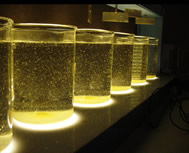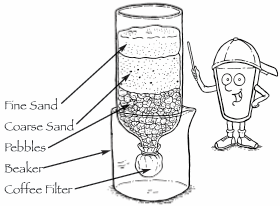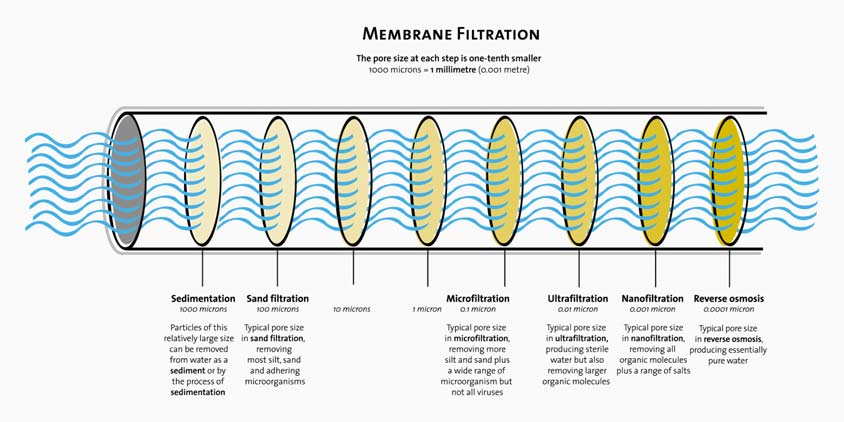CONVENTIONAL WATER TREATMENT: COAGULATION AND FILTRATION FACT SHEET
What is the Conventional Method to Treat Water?
Many water treatment plants use a combination of coagulation, sedimentation, filtration and disinfection to provide clean, safe drinking water to the public. Worldwide, a combination of coagulation, sedimentation and filtration is the most widely applied water treatment technology, and has been used since the early 20th century. For more information about the disinfection portion of the treatment process, see the Chlorination fact sheet.
What is Coagulation?
The coagulation process involves adding iron or aluminum salts, such as aluminum sulphate,
ferric sulphate, ferric chloride or polymers, to the water. These chemicals are called coagulants, and have a positive charge. The positive charge of the coagulant neutralizes the negative charge of dissolved and suspended particles in the water. When this reaction occurs, the particles bind together, or coagulate (this process is sometimes also called flocculation). The larger particles, or floc, are heavy and quickly settle to the bottom of the water supply. This settling process is called sedimentation. The following diagram illustrates the basic reactions and processes that occur during coagulation.
Process of Coagulation, Flocculation and Sedimentation
The chart below shows the length of time that is required for particles of different sizes to settle through the water.
Settling Time for Particles of Various Diameters;
Peterson, H. G. 2001. Rural Drinking Water and Waterborne Illness. In: Maintaining Drinking Water Quality, Lessons from the Prairies and Beyond, Proceedings of the Ninth National Conference on Drinking Water. Regina, Saskatchewan, Canada. May 16-18, 2000. Canadian Water and Wastewater Association. W. Robertson (Editor).
In a water treatment facility, the coagulant is added to the water and it is rapidly mixed, so that the coagulant is circulated throughout the water. The coagulated water can either be filtered directly through a medium filter (such as sand and gravel), a microfiltration or ultrafiltration membrane, or it can be moved to a settling tank. In a settling tank, or clarifier, the heavy particles settle to the bottom and are removed, and the water moves on to the filtration step of the treatment process.
What is Removed During Coagulation? What is Added?
Coagulation can successfully remove a large amount of organic compounds, including some
dissolved organic material, which is referred to as Natural Organic Matter (NOM) or Dissolved
Organic Carbon (DOC). Coagulation can also remove suspended particles, including inorganic
precipitates, such as iron. A large amount of DOC can give water an unpleasant taste and odour, as well as a brown discolouration. While coagulation can remove particles and some dissolved matter, the water may still contain pathogens. In an international report published in 1998, it was found that coagulation and sedimentation can only remove between 27 and 84 percent of viruses and between 32 and 87 percent of bacteria. Usually, the pathogens that are removed from the water are removed because they are attached to the dissolved substances that are removed by coagulation. In the picture below, the coagulants have been added to the water, and the particles are starting to bind together and settle to the bottom.
Coagulation jar test in a water treatment plant
As coagulation does not remove all of the viruses and bacteria in the water, it cannot produce
safe drinking water. It is, however, an important primary step in the water treatment process,
because coagulation removes many of the particles, such as dissolved organic carbon, that make water difficult to disinfect. Because coagulation removes some of the dissolved substances, less chlorine must be added to disinfect the water. A municipal water treatment plant can save money by using less chlorine, and the water will be safer, because trihalomethanes (THMs) are a dangerous by-product that results from the reaction of chlorine with NOM.
With accurate dosages and proper application, the residuals of the added chemicals generally do not pose a problem. Residuals are the by-products that remain in the water after substances are added and reactions occur within the water. The particular residuals depend on the coagulant that is used. If ferric sulphate is used, iron and sulphate are added to the water. If ferric chloride is used, iron and chloride are added. And if aluminum sulphate is used, aluminum and sulphate are added. The majority of municipal water treatment plants use aluminum sulphate as the coagulation chemical. Generally, water treatment facilities have the coagulation process set up so that the coagulant chemicals are removed with the floc. However, it is widely accepted that treatment facilities that use aluminum based coagulants often have higher levels of aluminum in their treated water, but not by much. In Canada, Health Canada has different guideline parameters for treatment facilities that do not use aluminum based coagulants (i.e., 0.1 mg/L) and those that do (i.e., 0.2 mg/L).
What Happens to Water During Filtration?
The second step in a conventional water treatment system is filtration, which removes particulate matter from water by forcing the water to pass through porous media. The filtration system consists of filters with varying sizes of pores, and is often made up of sand, gravel and charcoal. The diagram below shows a homemade filter that is made up of particles of various sizes. The diameter of a grain of fine sand is approximately 0.1 millimetre, so only particles with diameters less than 0.1 millimetre would pass through the fine sand layer. This filter would not be able to produce safe drinking water, because many contaminants are much smaller than 0.1 millimetre (such as viruses, which can be as small as 0.000001 millimetre in diameter!).
Homemade Filter
There are two basic types of sand filtration; slow sand filtration and rapid sand filtration. Slow
sand filtration is a biological process, because it uses bacteria to treat the water. The bacteria
establish a community on the top layer of sand and clean the water as it passes through, by
digesting the contaminants in the water. The layer of microbes is called a schumtzdecke (or
biofilm), and requires cleaning every couple of months, when it gets too thick and the flow rate declines. After the schumtzdecke is removed, the bacteria must be allowed several days to reestablish a community before filtering can resume. Slow sand filtration systems have been used for many years; the first systems operated in London in the 19 th century. However, slow sand filtration systems require large areas of land to operate, because the flow rate of the water is between 0.1 and 0.3 metre per hour. Due to the land area that is required and the down-time for cleaning, rapid sand filters, which were developed in the early 20 th century, are much more prevalent today.
Rapid sand filtration is a physical process that removes suspended solids from the water. Rapid sand filtration is much more common than flow sand filtration, because rapid sand filters have fairly high flow rates and require relatively little space to operate. In fact, during rapid sand filtration, the water flows at a rate up to 20 metres per hour. The filters are generally cleaned twice per day with backwashing filters and are put back into operation immediately.
Modern technology has allowed the effectiveness of slow sand filtration to be used with the rapid pace and small land area required for rapid sand filtration. In fact, after conventional water treatment methods failed to successfully treat the water at Saddle Lake First Nation, Dr. Hans Peterson found that a biological water treatment process, which incorporated aspects of both slow and rapid sand filtration, could successfully treat the water to Canadian Drinking Water Quality Guidelines. For more information about how the Saddle Lake water was treated, read the Ultrafiltration, Nanofiltration and Reverse Osmosis fact sheet, or read the article “Due diligence equals safe drinking water” that was written by Dr. Peterson and published in Aboriginal Times.
The ability of conventional treatment, such as sedimentation and sand filtration, is compared below with different types of membrane filtration, including microfiltration, ultrafiltration, nanofiltration and reverse osmosis. A membrane filtration system may also be called a particle filter. Particles with a diameter greater than one millimeter, such as gravel and sand, are removed through the sedimentation process. Particles with a diameter greater than 100 microns (or 0.1 millimetre), such as fine sand, are removed through sand filtration. As the pore size decreases, a greater proportion of material is retained as the water passes through the filter. Often, a combination of several sizes of filters is used, so that large particles do not clog up too quickly. By using finer material, such as sand or expanded clay, or applying a coagulant, it is possible to remove small particles between one and 100 microns in size. For more information about other membrane processes, see the Ultrafiltration, Nanofiltration and Reverse Osmosis fact sheet.
Membrane Filtration System
What is Removed During Filtration?
The particles that are removed from the water during filtration depend upon the size of filters
that are used. Slow sand filtration removes bacteria, protozoa and viruses, and produces
essentially clean water, though it is still advisable to use a disinfectant as a precautionary
measure.
Rapid sand filtration removes suspended particles, which may have bacteria attached, but in
general does not remove bacteria, protozoa, or viruses. In water treatment plants, filtration
removes a large number of contaminants, but still requires disinfection to produce drinking water that is safe. Though rapid sand filtration cannot effectively remove bacteria and viruses, it is an important step in the water treatment process. Like coagulation, filtration can remove the suspended and dissolved matter, so that disinfection is more successful with a reduced amount of chlorine. For more information about filtration in Nepal, including how rusty nails can remove arsenic from the water, see the Filters for Families fact sheet.
The Safe Drinking Water Foundation has educational programs that can supplement the
information found in this fact sheet. Operation Water Drop looks at the chemical contaminants that are found in water; it is designed for a science class. Operation Water Flow looks at how water is used, where it comes from and how much it costs; it has lessons that are designed for Social Studies, Math, Biology, Chemistry and Science classes. Operation Water Spirit presents a First Nations perspective of water and the surrounding issues; it is designed for Native Studies or Social Studies classes. Operation Water Health looks at common health issues surrounding drinking water in Canada and around the world and is designed for a Health, Science and Social Studies collaboration. Operation Water Pollution focuses on how water pollution occurs and how it is cleaned up and has been designed for a Science and Social Studies collaboration. To access more information on these and other educational activities, as well as additional fact sheets, visit the Safe Drinking Water Foundation website at www.safewater.org.
Want to help teach students there is a better way to treat drinking water? Chip in $5 today to help us send Operation Water Biology kits to schools so that students can build small-scale models of biological water treatment systems! Or donate $20 or more and receive an Official Donation Receipt for Income Tax Purposes.
Resources:
Government of Canada. 2015. Drinking Water. https://www.canada.ca/en/health-canada/services/environmental-workplace-health/water-quality/drinking-water.html
Huisman, L & Wood, W. E. (1974). Slow sand filtration / L. Huisman, W. E. Wood. World Health Organization. https://apps.who.int/iris/handle/10665/38974
LeChevallier, Mark W, Au, Kwok-Keung & World Health Organization. Water, Sanitation and Health Team. (2004). Water treatment and pathogen control : process efficiency in achieving safe drinking water / Mark W. LeChevallier, Kwok-Keung Au. World Health Organization. https://apps.who.int/iris/handle/10665/42796
Sustainable Sanitation and Water Management. (n.d.). Rapid Sand Filtration. https://sswm.info/sswm-university-course/module-6-disaster-situations-planning-and-preparedness/further-resources-0/rapid-sand-filtration






